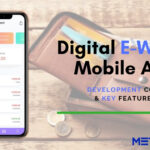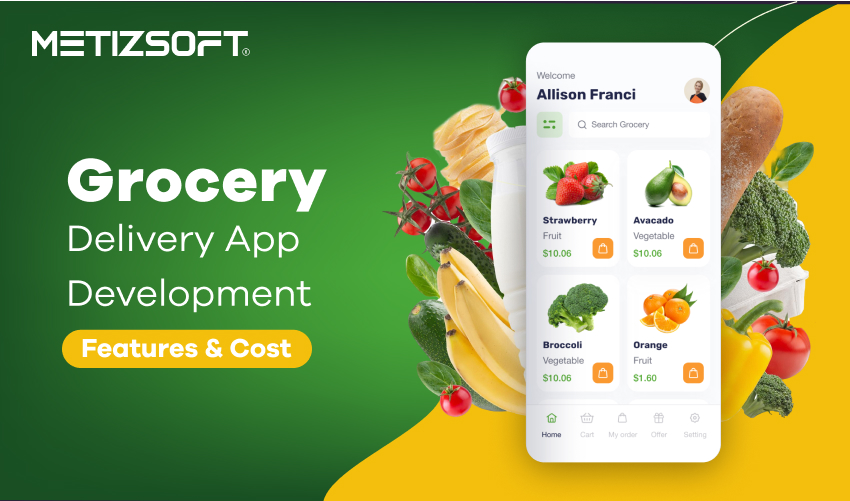
In the rapidly evolving and advancing era of the internet, smartphones, and apps, no one wants to leave the comfort of their home and shop outside. Plus, why bother going outside when you can buy and deliver the same thing to your doorstep with only a few clicks? An on-demand grocery delivery app is a revolution. It may be less successful than some clothes, fashion, and other shopping sites, but it is undoubtedly the most valuable invention for tech enthusiasts and entrepreneurs.
Let’s learn more about “Grocery Delivery App” in this informative blog, from its definition to features, statistics, cost, and many other prospects.
Table of Contents
Define Grocery Delivery App
The name says it all. A grocery delivery app is similar to other shopping apps but with a different category. It allows users to purchase groceries online. Users can browse through a virtual store and add products to their cart.
Once an order is placed, the groceries are delivered to the user’s selected location. Using a grocery delivery app saves valuable time by eliminating the need to visit a physical store, select items, wait in long checkout queues, and navigate traffic to return home.
These apps provide real-time product tracking, personalized recommendations, and secure online payment options. They also comprise various payment options, including online payment via cards, digital wallets, mobile banking apps, and cash-on-delivery.
Grocery Delivery App Statistics
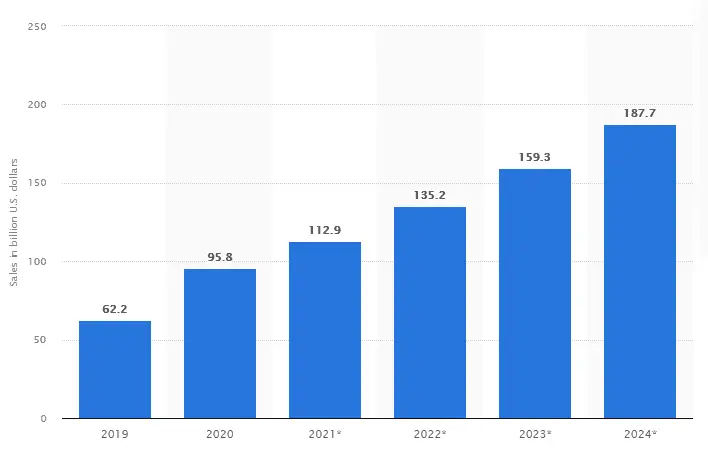
This statistic highlights the revenue generated from online grocery shopping in the United States between 2019 and 2024. In 2020, the online grocery market in the U.S. was estimated to have generated approximately $95.8 billion in sales. The sales are projected to increase and reach $187.7 billion by 2024.
Grocery Delivery App must-have features
User Panel:
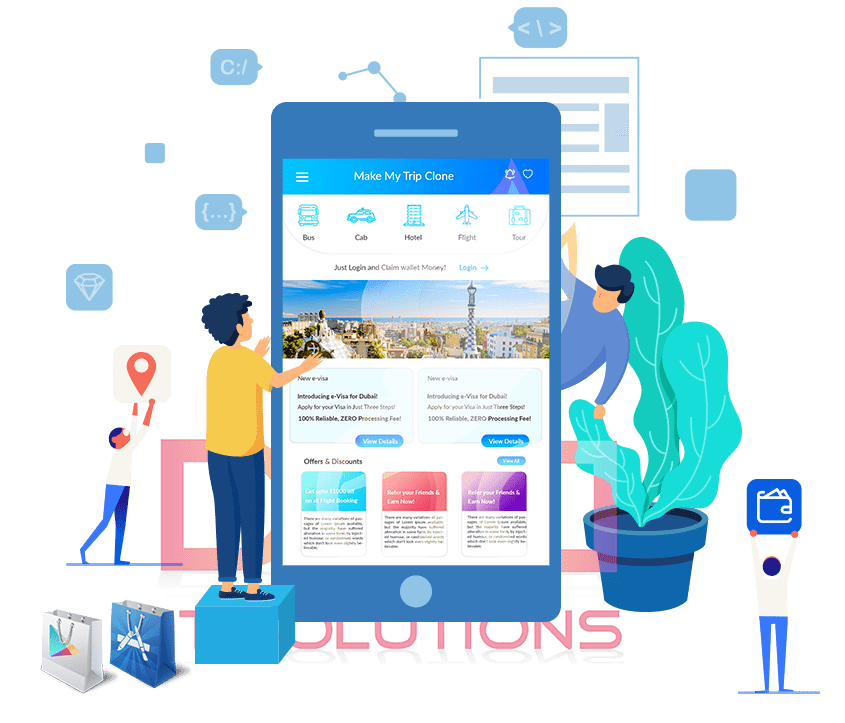
- Signup/Login: Users should be able to create accounts on the app and log in with registered credentials such as username and password.
- Login with social media: A user can directly login via social media.
- Category selection: Users choose a category to shop in after logging in. For fruits, select the fruit category.
- Bookmark Feature: If users find a product interesting, they can mark it as a favorite and access it later.
- Add To Cart: To buy a product, add it to your cart and checkout. First, add selected items to your cart. It’s like a virtual basket. You can add multiple products at once.
- Multiple Payment Options: Users should conveniently make payments using the app, including credit and debit cards.
- Review and Rating Feature: A user must flexibly give ratings and reviews for products, which are visible to all users.
- Checkout Feature: A seamless checkout feature is vital for any marketplace application.
- Coupons and Promotions Feature: Users should be able to utilize any offers or coupons associated with a particular product.
- Referral Feature: A user can refer friends and earn rewards from the app.
- Return and Replacement Feature: If users receive a faulty product, they can quickly request a return or refund through the application.
Admin Panel:
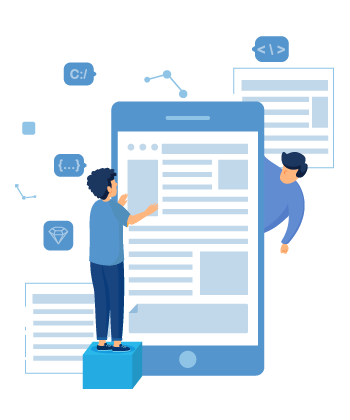
- Login: The administrator can access the backend application by logging in.
- Dashboard: The admin can view informative data on the dashboard, such as business figures and other relevant information.
- Return and Replacement Management: The admin will decide whether to approve or reject returns, replacements, and refunds based on the customer’s request.
- Business Reports Section: The admin can now easily filter and sort business reports.
- User Management: The admin can manage all application users from the admin panel.
- Content Management: The admin will manage all the application content.
- Payment Management: Admin can manage payment transactions while clients handle taxes and commissions.
- Product Management: The admin can add or disable products in bulk from the admin panel.
Grocery Delivery App Panel
A delivery management platform is needed to help businesses with timely deliveries and delivery confirmation and provide delivery boys with the necessary information. While third-party apps offer end-to-end tracking, a dedicated app is more efficient and convenient.
- Delivery Boy Login: The delivery person can log into the app and view all assigned orders. Then, they can pick up the orders one by one.
- Delivery Boy Tracker: The app will use GPS tracking on Google Maps to allow customers to track their deliveries in real-time.
- Route Optimization: The application automatically generates the shortest route using Google Maps based on the customer’s location.
- Signature Feature: This feature will allow the user to confirm delivery by signing in to the application.
- Return Process from the App: Once approved, the delivery person notifies us, and the product can be collected or replaced using the same process as delivery.
Steps Involved in Creating a Robust Grocery Delivery App
Here are the core steps that you can follow to create a unified grocery delivery app:
1. Define your business model – The first step should be to choose the most suitable business model for your on-demand grocery delivery app.
- Aggregator model: You connect customers with existing grocery stores and manage delivery logistics. (e.g., Instacart)
- Inventory model: You stock and manage your inventory and fulfill deliveries. (e.g., Amazon Fresh)
- Hybrid model: A combination of the above, offering flexibility.
2. Plan Core Features — Business owners must consider the three parts of the application when developing a grocery delivery app.
- Customer App: Browse products, build carts, checkout, track deliveries, and manage accounts.
- Store Partner App (Aggregator model): Manage product listings, orders, and deliveries. (Optional for Inventory model)
- Delivery Driver App: Track assignments, optimize routes, navigate deliveries, and communicate with customers.
- Admin Panel: Manage users, stores, products, orders, deliveries, promotions, and analytics.
3. App Development: It involves three primary aspects of app development:
- UI/UX Design: Create user-friendly and intuitive interfaces for all app components.
- Mobile App Development: Build native apps for iOS and Android or a cross-platform solution.
- Backend Development: Develop server-side functionalities like order processing, payment integration, and data management.
4. Testing & Deployment – After creating a grocery delivery app, thoroughly test and launch an on-demand grocery delivery app on desired platforms such as the Google Play Store and App Store.
- Thorough Testing: Ensure all functionalities work seamlessly across platforms.
App Store & Play Store Launch: Submit your apps for review and publication.
5. Maintenance & Growth — Lastly, track your app’s usage and performance to receive regular updates and include new features when necessary to give customers a flexible user experience.
- Bug Fixes & Updates: Continuously address issues and improve app performance.
- New Features: Introduce features based on user feedback and market trends.
- Marketing & User Acquisition: Attract customers and stores to your platform.
Grocery App Development Cost
Developing a grocery app can be a complicated task involving several aspects such as design, features, platforms, and more. Creating a grocery delivery app typically ranges between $30,000 and $55,000, depending on whether for Android or iOS. However, the actual cost may vary depending on the hourly rates charged by the mobile app development company you choose.
The cost of developing an app depends on its complexity and the features you want to integrate. Along with app development, you also need to allocate a considerable budget for marketing.
Final Words
The idea of a grocery delivery app is more than a decade old. However, these helpful apps’ real value shines during and after the COVID-19 pandemic. In 2024, Grocery Delivery Apps will make everyone sit and relax at home while getting doorstep groceries delivered from their favorite store.
These grocery delivery apps have excellent features, simple steps, and costs that anyone can understand and navigate. With innovative features, streamlined development, and transparent cost structures, these apps have become indispensable companions in our daily lives.
At Metizsoft Solutions a leading grocery delivery app development company, we are committed to crafting seamless experiences that align with modern consumer expectations. Regarding grocery delivery app development, we boast about our excellence like no one else while ensuring best-in-class development results.
Read More:
- On-Demand Dry Cleaning & Laundry Mobile App Development Cost and Key Features
- On-Demand Digital E-Wallet Mobile App Development Cost and Key Features
AboutChetan Sheladiya
Related Posts
This Is Why You Should Hire Dedicated Development Team For Your Next Project
Just think about how much easier and quicker things would be if a group of individuals was organized into a single unit...
Why React Native is an Ideal Choice For Mobile App Development in 2023?
We all have heard of React Native, right? React Native is an open-source mobile application framework created by Facebook....
